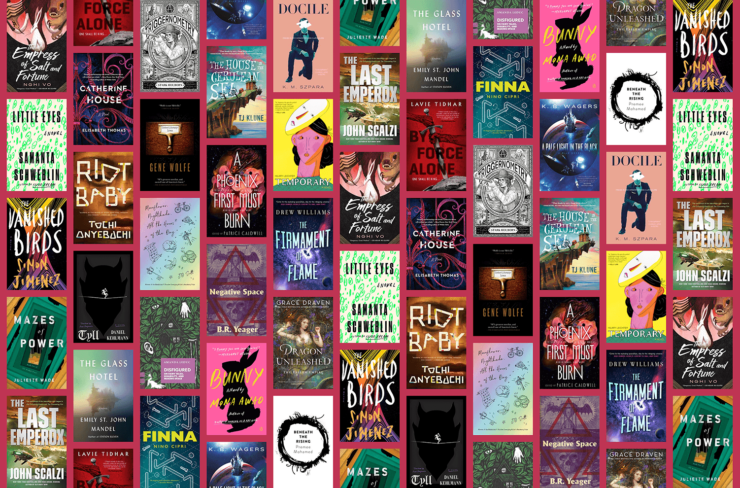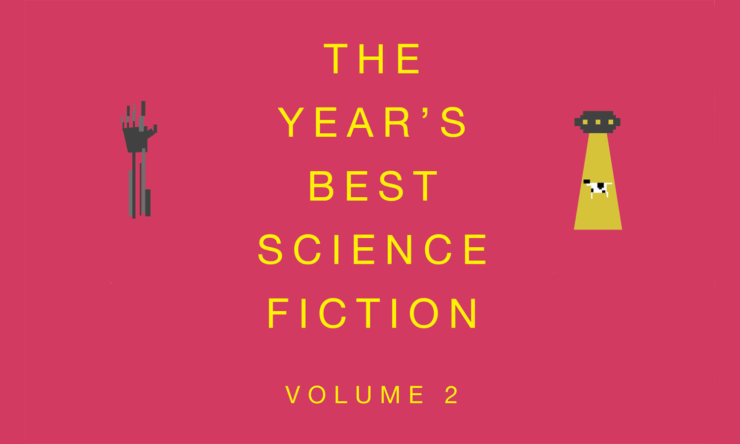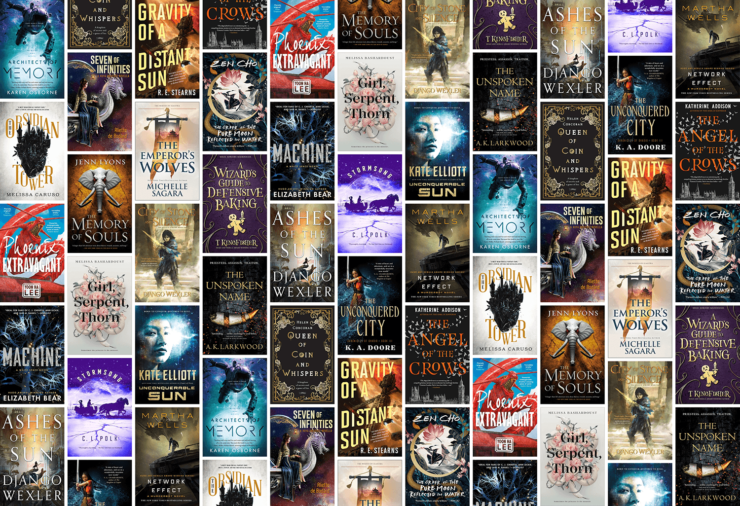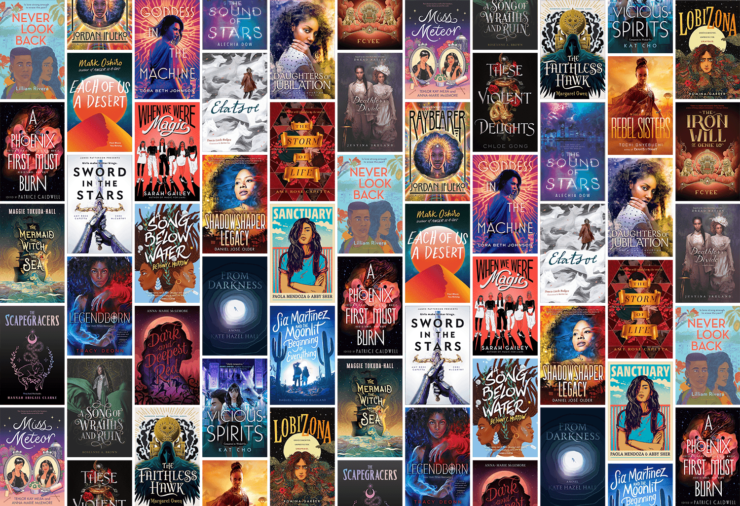At Tor.com, we’re extremely proud of our short fiction program and of course the output of excellent SFF titles from Tordotcom Publishing—but we also love our hundreds of stand-alone feature articles, covering everything from the latest superhero movies to favorite childhood books.
We’ve gathered up a few of our favorite pieces from the year—notable standouts that include meditations on gender in Dune and mortality in Middle-earth, celebrations of hopepunk and Steven Universe, and reflections on the power of stories to weather any crisis.
While this list is focused on individual articles, we’d also like to highlight our many weekly columns—this year we were proud to present Never Say You Can’t Survive, a how-to series about the storytelling craft blended with memoir and anecdotes from author Charlie Jane Anders. We also launched the Terry Pratchett Book Club, a reread hosted by Emmet Asher-Perrin appreciating the work of a great author who knew how to make sense of senseless things. And to celebrate the 25th anniversary of its original run, Keith R.A. DeCandido embarked on a rewatch of Star Trek: Voyager.
Here are just some of the best of our non-fiction articles from the past year!
February
Mortal Men Doomed to Die: Death as a Gift Is Debatable in Middle-earth by Jeff LaSala
We already know that even in Middle-earth, all Men die at some point. Obviously. But it’s not unless we read Appendix A in The Lord of the Rings that we see mortal death referred to as something other than a tough break. The narrator calls it “the Gift of Men” when speaking of the long-lived Númenóreans. Arwen Undómiel calls this fate “the gift of the One to Men” at her husband’s own deathbed, where “the One” is essentially God, a.k.a. Eru, whom the Elves named Ilúvatar. And this all might seem strange at first, for nowhere else in Tolkien’s seminal book does he explain why death might be seen as a gift.
Connecting With Horses Is Like Living in a Fantasy Novel by Judith Tarr
Deep-down, in it for the long haul horse people have a look to them. They come in all shapes and sizes, and they aren’t all leathery whipcord types in well-worn breeches or a cowboy hat that’s seen a thousand miles and expects to last a thousand more. But you can spot them.
The Revolution Will Be Dramatized by Bethany C. Morrow
Catching Fire came out November 2013. Mockingjay: Part I came out November 2014. In between, Mike Brown was killed by a police officer in Ferguson, Missouri, and the Ferguson Uprising took place.
This essay is about what it was like to live in an America that can rapturously and enthusiastically consume and cosplay revolution, and can look on real world resistance with disdain.
March
Hopepunk and the New Science of Stress by Rebecca Diem
When I first saw encountered the term “hopepunk,” I felt an immediate sense of recognition. To me, it described the state of joyful protest I aspire to: Knowing enough about the world to be absolutely furious, but choosing optimism anyway.
Books in Which No Bad Things Happen by Jo Walton
With politics, pandemics, and polar vortices, sometimes you want your reading to be all upbeat. But yet, there aren’t many books where nothing bad happens.
Manga and Anime in Which No Bad Things Happen by Ada Palmer
A crisis is exhausting on every level, emotional especially, so here are some good manga and anime where no bad things happen, to lighten your spirits without the risk of getting them down…
The Magic of Libraries: Where Fantasy Meets Reality by Rachel Ayers
Libraries are magical. We know this, as readers: Rare is the book lover who can’t recall the moment of sheer wonder and exhilaration the first time they understood what it meant to use a library. All of these books! For free!
If the Vampire Lestat Was Your Boyfriend… by Wendy Xu
If Lestat was your boyfriend, he would cry a lot. Like, a lot. He would cry crimson tears because all vampires weep blood for extra theatrical effect, thank you Anne Rice.
Queering SFF: 12 Authors, Critics, and Activists on What’s Changed in the Last Ten Years by Lee Mandelo
At the start of a new decade, I wanted to offer readers a bit of a retrospective with some folks who have been part of the broader field of queer SF/F across that same timeline. And by “a bit of a retrospective,” I mean a big ol’ roundtable discussion with some of the finest individuals our field has to offer—critics, organizers, writers, and occasionally all of those at once.
April
Saving Aerith: Life and Death in Final Fantasy VII by K.W. Colyard
No matter how many times she dies on screen, Aerith will always be alive again whenever someone begins a new playthrough of Final Fantasy VII. […] Gamers know that this is true, and they respond with repeated attempts to save Aerith from certain doom, even if they are unable to articulate their experiences and reactions as emotional ones.
Internal Circumstances Are the Only Thing You Can Control: Mourning The Magicians by Molly Templeton
I want to talk about how these characters aren’t heroes. They aren’t anti-heroes, either. The Magicians isn’t a show about redefining what it means to be a hero, but it is, in part, about asking whether that’s even a useful way to measure anything. It’s what Quentin Coldwater has to get over: the dream of being a chosen one.
Station Eleven, Mr. Burns, and (Re)telling Stories to Survive by Natalie Zutter
There seem to be two types of people: Those who have absolutely no interest in pandemic narratives at this particular point in history, and those who are strangely soothed by reading about how fictional characters respond to a world paused, and then halted, by a hypothetical disease that suddenly seems very familiar.
On the Significance of Harley Quinn’s Split Lip in Birds of Prey by Leah Schnelbach
One of the many fantastic things about Birds of Prey is the way it gleefully throws different visual languages and references into a movie blender and expects its audience to keep up. Characters and iconography from the DC Universe crash right into a neon ’80s aesthetic. Gotham sometimes seems like a real city, and sometimes seems more like a whimsical, Burton-esque fever dream. But right when we settled in to enjoy a fun rollercoaster of a movie, the film throws two very specific visual cues together and changes its whole tone.
Didn’t I Write This Story Already? When Your Fictional Pandemic Becomes Reality by Naomi Kritzer
Sometimes, you’re haunted by your own stories. I wrote “So Much Cooking” in 2015: in it, a food blogger describes cooking in quarantine during a pandemic, feeding an ever-increasing number of children she’s sheltering at her house with an ever-decreasing supply of food. For over a year after I wrote the story, every time I saw powdered egg replacer at the store I’d be tempted to buy some. Just in case.
Dune’s Paul Atreides Should Be Non-Binary by Emmet Asher-Perrin
If you have read Dune or watched any of its on-screen iterations, then you know all about Paul Atreides. The son of Duke Leto and Lady Jessica, trained in the Bene Gesserit ways, adopted by the fremen of Arrakis to become the legendary Muad’Dib. Paul is the culmination of a deeply unsettling eugenics program to create something called the Kwisatz Haderach, a being who can see into the future and project himself backwards and forwards in time.
And he could have been science fiction’s best known non-binary protagonist.
It’s Time to Reevaluate Penny Dreadful, a Misunderstood Gothic Masterpiece by Tyler Dean
I was always baffled by the reception that Penny Dreadful got, both from critics and casual viewers. It was repeatedly snubbed by the awards circuit and received the dubious and baffling nomination for “best campy show” from Fangoria. In my own circle of Victorian-fiction academes, it was especially loathed—a fact I found borderline distressing, given how perfectly it wed Victorian Gothic fiction to the prestige drama format.
Avengers: Endgame Never Showed Us Its Greatest Scene by Emmet Asher-Perrin
It’s been a year since the Marvel Cinematic Universe ended its first epic arc, culminating in Avengers: Endgame […and] I would like to register a complaint: You see, the most interesting arc of the film is nowhere to be found on screen. And I request that Marvel produce the deleted footage of this arc, otherwise I’m not really sure why this movie was made at all.
I’m speaking, of course, about how Doctor Stephen Strange stage managed an entire apocalypse solely for Maximum Dramatic Effect.
May
Howl-ever It Moves You: Diana Wynne Jones and Hayao Miyazaki Do the Same Work With Different Stories by Elyse Martin
We often see Asian stories adapted for a Western, English-speaking market, but Howl’s Moving Castle is one of the most famous cases of the reverse. Hayao Miyazaki’s 2004 film is a loose adaptation of Diana Wynne Jones’s 1986 novel, which Jones described as “rich and strange, full of the most beautiful animation,” by someone who “understood my books in a way that nobody else has ever done.” Miyazaki deeply understands the work the novel does: using popular fantasy tropes to interrogate and disprove dominant social narratives, and thus deprive them of their power.
Classic SF With Absolutely No Agenda Whatsoever… by James Davis Nicoll
Golden Age science fiction was, of course, a wonder of agenda-free writing: No political, racial, or gender concerns tainted their deadly deathless prose. Heck, a lot of old-timey SF never so much as hinted that visible minorities or women even existed! Modern authors might find these old-style works inspiring. Perhaps some examples are in order.
(Sadly, there is still no sarcasm font available on this site…)
Love Can’t Make You a Villain: How She-Ra’s Catra Helped Make Sense of My Heart by Emmet Asher-Perrin
We all have our types. This holds true in fiction as well as life, the traits that resonate with us and help us form friendships and deeper attachments. The attributes that we recognize in ourselves that help us to better understand our own feelings and foibles. Types are useful for helping us organize the bits and pieces of being alive that don’t always make sense to us.
When I started watching She-Ra and the Princesses of Power, I instantly recognized Catra as one of my types.
What If I Told You John Wick Was a Portal Fantasy by Leah Schnelbach
The first John Wick begins as a film we’ve seen many times before. A hitman has retired. He was drawn into “normal” life by love, […] but, as in all of these kinds of movies, the normal life is a short-lived idyll, violence begets violence, and the hitman is Pulled Back In.
The thing that makes Wick so beautiful is that what he gets Pulled Back Into is not the standard revenge fantasy. Instead being Pulled Back In means literally entering another world, hidden within pockets of our own. Because in addition to being a great action movie, John Wick is a portal fantasy.
If Rand al’Thor Were Your Boyfriend… by Caroline Perny
If Rand al’Thor were your boyfriend, he’d constantly flex and make you tell him how cool his dragon tattoos were. “Oh yeah, honey, these are so badass, and I definitely haven’t seen five guys in Ed Hardy shirts with the exact same ones,” you’d say, brimming with sincerity.
June
I Have No Mouth, and I Must Scream: The Duty of the Black Writer During Times of American Unrest by Tochi Onyebuchi
Since before Ralph Ellison’s Invisible Man, narratives by Black Americans about Black Americans have performed a sort of zoological function. In conjunction with or perhaps with utter disregard for a work’s literary merits (depending on its audience), a reader might approach such a book the way they might watch a documentary.
Creating a Queer Hopepunk Canon: Lady Gaga, Janelle Monae, Lil Nas X, and the Visual Narration of Joyful Queer Futurism by Christina Orlando
Lady Gaga’s presence has always been about hope, joy, and inclusion, specifically geared toward the queer community. […] For queer creators like Gaga, hopepunk ideology becomes narrative fuel, a vehicle through which to be loud, proud, and unapologetic in working towards a future filled with joy, love, and dancing. And she works alongside other queer creators in doing so, effectively creating a queer hopepunk canon.
Anxiety, Empathy, and Making Sense of the Senseless Through Storytelling by Kali Wallace
The first kid we had to kill never wanted to be a soldier. He wanted to be a painter. That was about all we knew about him; he wasn’t on our team. His name was Ignatz, he had grass-green hair and Harry Potter glasses, he wanted to be a painter, and we had to kill him.
“Oh no,” I said. “That’s not fair. That’s not okay. I don’t like this at all.”
Let me clarify: I’m talking about a video game.
Growing Up With Percy Jackson by AM Gelberg
If you had asked me, then, what I liked about Percy Jackson, I would have told you that I liked the adventure and the danger, the funny chapter titles, the magic. […] Here’s what I’d tell you now: Percy Jackson is, at its core, about identity. It centers itself around family, around community. It reckons with bloodline and with lineage. Percy Jackson is about finding the parts of the self that matter. It’s about contextualizing the narratives we tell about ourselves
July
Representation Without Transformation: Can Hollywood Stop Changing Cartoon Characters of Color? by Andrew Tejada
When I first saw the trailer for Pixar’s Soul in theaters, I leaned forward in my seat, ready to give it a standing ovation. My 20-something Black and Puerto Rican self was thrilled that one of the top animation studios in the world was committing to a movie where an African-American man would be the lead character. But when the protagonist was transformed into a fuzzy blue…soul creature during the trailer, my excitement changed to disappointment.
August
Hannibal and Steven Universe Are the Same Show by Leah Schnelbach
The defining works of art of this era tell the same story, and those two works are Hannibal and Steven Universe.
Now, yes, obviously, they are told through different lenses and aimed at a slightly different audience. Bryan Fuller wrings a story of love out of murder and gore. Rebecca Sugar wrings a story of trauma recovery out of a candy-colored adventure tale. They both begin in the same place, though: two special people, with a special gift of empathy, are squeezed stone dry by organizations who use their skill to their own ends.
The African Superhero and the Legacy of Captain Africa by Suyi Davies Okungbowa
For many Americans—and in essence, many readers the world over—Captain Africa was the first contact with a comic and superhero written, illustrated and published by Africans domiciled on the continent. The first African #ownvoices superhero comic to go global, if you will.
A few years into the 1990s, Captain Africa slowly waned, before vanishing completely. Along with its creator, Ghanaian Andy Akman, and its Nigerian publisher, African Comics Limited, almost every facet of its existence is now lost. Yet its influence on more recent superheroes from the continent lingers, and continues to shape work written and produced by its own people today.
Unghosting the Secret Rooms: Reclaiming Haunted Spaces for the BIPOC Imagination by Angela Maria Spring
We are a haunted country and this is a haunted time in a haunted world, especially for those of us who already occupy the liminal space of other, such as myself. We find comfort in strange places.
September
Horns, Feathers, and Scales: Reclaiming Genderqueer Monstrousness by Tessa Gratton
We’ve known for ages that monsters in stories aren’t inherently bad. They’re just othered. They’re outside the norm. That’s why there are so many queer monsters—outside or beyond the norm is what queer means. But I couldn’t shake the heart-ache of aligning myself, and therefore all of genderqueerness, with monstrosity.
Grading the Best Time Travel Movies Ever Made by Joe George
Does good time travel science make for a good time travel movie? While there are certainly hard science fans out there, and scientific discovery has always opened up storytelling possibilities, we don’t always place that demand on other types of stories.
Why Batman Is a Terrible Superhero (Or, Why Our Present Social Crises Demand a Different Class of Hero) by Daniel Whyte IV
Why do we need superheroes? Why are we attracted to them? Why are comic books and superhero movie franchises the mythology of the modern age?
More importantly: why has our collective fascination with mega-powerful men (and sometimes aliens) remained steadfast even as their closest real-life equivalents—the “leader of the free world” and “commander-in-chief” of the world’s greatest armed force, along with the exceedingly wealthy heads of giant tech organizations and retail companies—repeatedly prove incapable of (or unwilling to) effectively address the vast and complex issues facing swathes of the global population?
October
“Oh, Frak” — Avoiding the Censors the SFF Way by CD Covington
As language users, we thus have a few tricks in our bag for how to avoid taboos, and we use them all the time. In many cases, we use avoidance words without even knowing that they’re avoiding something!
When script writers had to avoid bad words because of FCC broadcast rules, they could take a variety of tacks, just like we do every day. You get lots of “oh, geez” and “shoot” or “freaking” in your contemporary (and historical) fare, but in SFF-land, writers have another trick up their sleeves: alien languages, or even made-up future-English words.
The Monstrous Machines of Corporate Capitalism by K. Eason
Since Frankenstein, science fiction has worried about the consequences of creating artificial life. Would we make monsters (or robots, or monster-robots) that would destroy their creators? Or can we duplicate whatever it is that makes us human?
How Not to Be All About What It’s Not All About: Further Thoughts on Writing About Someone Else’s Culture and Experience by Nisi Shawl
Authors who care about inclusive representation in fiction are often deeply concerned about messing it up. We think we can do too little in pursuit of “Writing the Other.” We think we can do too much. We think we can hurt people by unknowingly perpetuating racial stereotypes, religious stereotypes, and all the rest of the tedious clichés unimaginative authors avail themselves of. All of this is true, and all of these dangers are avoidable with work.
November
The Vegetarian Vampire: Unpacking the Metaphor of Modern Vampire Stories by Natalie C. Parker
Lestat is arguably one of the greatest vampires in all undead imaginings, but it is his sadsack companion Louis I want to discuss. Louis, who clung to his humanity with every brooding fiber of his being. Louis, who drank the blood of rats rather than take human life. Louis, whose desperation for real sustenance eventually drove him to drink the blood of a dying child—an act that would haunt him for, well, the rest of his undead days. The key here is that Louis tried to maintain a connection to his humanity by denying himself the thing that vampires require in order to live: human blood.














